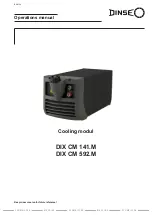
CAPACITY CONTROL
It is necessary to prevent the recirculating water from
approaching freezing conditions when the unit is
operating under load. Capacity control on centrifugal fan
units may be achieved through fan cycling, capacity con-
trol dampers, the ENERGY-MISER® Fan System, or two-
speed motors. Capacity control dampers offer the greatest
protection and should be used for close temperature con-
trol. Capacity control on axial fan units (VC2 only) may be
achieved by fan cycling or two-speed fan motors.
Warning: Rapid on-off cycling can cause the fan
motor to overheat. It is recommended that controls be
set to allow a maximum of six-off cycles per hour.
Multiple fan motors serving a single coil, fill section, or fan
section must be cycled simultaneously. This applies to
models VT1-478 through VT1-600, VF1-216, VF1-432,
VC1-540 through 804, VC1-1158-1608, and VC2-319
through 1774.
Units with two-speed motors should have a 15-sec-
ond time delay during switch down from high to low
speed to avoid overloads on the low speed windings
of the motor. Units with the ENERGY-MISER® Fan
System should also have a 15-second time delay during
the switch down from high to low speed to avoid over-
loads on the lower horsepower motor.
Please note that capacity control dampers allow the
unit to operate longer and with closer control than the
ENERGY-MISER® Fan System, two-speed motor, and/or
fan cycling. The use of a modulating spray water by-
pass is
not a recommended method of capacity control.
Variable Frequency Drives
Motors: Applications employing variable frequency drives
(VFDs) for fan motor control must use inverter duty elec-
tric motors built in compliance with NEMA Standard MG.1,
Part 31. The standard fan motors normally furnished
with B.A.C. products are not intended for this duty
and will not be warranted if so applied.
Warning: When the fan speed of a Series V Closed
Circuit Cooling Tower or Evaporative Condenser is to
be changed from the factory set speed, including the
use of a variable speed control device, steps must be
taken to avoid operating at or near the fan’s “critical
speed” with resulting excessive vibration and stress-
es and the risk of personal injury and/or property
damage. Consult with your local B.A.C.
Representative on any application utilizing variable
speed control to determine whether any critical
speeds may be encountered and if any motor modifi-
cations may be required.
Recommended Operating Speeds: For optimum system
performance and equipment longevity, fan motors should
not be operated below 25% of full speed, nor within 10%
of any unit resonant frequencies. Contact your local
B.A.C. Representative for this information.
13
WARNING: Before performing any maintenance or
inspection, make certain all electric power has been
disconnected and locked in the off position.
Maximum Allowable Wire Runs: The VFD should be
located as close as possible to the inverter duty motor.
Depending on the style, operating voltage, and switching
frequency, the maximum recommended length of wire can
range from 20 to 200 feet. Consult the inverter manufac-
turer to determine the maximum allowable wire lengths for
your application.
PROTECTION AGAINST COIL FREEZING
(MODELS VF1 AND VFL ONLY)
The best protection against coil freeze-up is the use of
an antifreeze solution. An industrial grade inhibited ethyl-
ene glycol or propylene glycol solution is recommended
for most installations.
When an antifreeze solution is not possible, the system
must be operated to meet both of the following conditions.
1. Maintain the minimum recommended flow through the
coil at all times (see Table 5 below).
2. Maintain a heat load on the circulating fluid so that the
temperature of the fluid leaving the coil will not fall
below 50°F.
Minimum Coil Flow (GPM)
Model No.
VF1-009, VF1-018,
VF1-027, VF1-036
VF1-048
VF1-072
VF1-096, VF1-144N
VF1-144, VF1-216N
VF1-192, VF1-288N
VF1-288, VF1-432
VFL-012 thru VFL-048
VFL-072 thru VFL-096
50
75
100
125
200
250
400
65
125
TABLE 5. VF1 and VFL Minimum Coil Flow Requirements
If the process load is extremely light or shut off, it may be nec-
essary to apply an auxiliary heat load to the circulating fluid
to maintain the fluid at 50°F when freezing conditions exist.*
Draining the coil is not recommended as a normal
method of freeze protection. Frequent draining pro-
motes corrosion inside the coil tube. However, draining is
acceptable as an emergency method of freeze protection
if the coil is not protected by an antifreeze solution. The
local B.A.C. Representative should be consulted for
guidelines on the installation of an emergency coil drain
system.
*For evaporative chilling applications only, the leaving fluid temper-
ature can be maintained as low as 45°F with glycol solutions.
Consult the local B.A.C. Representative for necessary precaution.

















